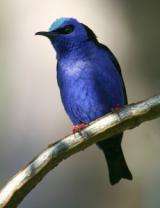Tropical birds waited for land crossing between North and South America: study

Despite their ability to fly, tropical birds waited until the formation of the land bridge between North and South America to move northward, according to a University of British Columbia study published this week in the Proceedings of the National Academy of Sciences Early Edition.
"While many North American birds simply flew across the marine barriers that once separated the continents, tropical birds, especially those in Amazon forest regions, began colonization of North America almost entirely after the completion of the land bridge," says lead author Jason Weir, who conducted the study as part of his PhD at UBC.
"This study is the most extensive evidence to date that shows the land bridge playing a key role in the interchange of bird species between North and South America and the abundant biodiversity in the tropical regions," says Weir, now a post-doctoral fellow at the University of Chicago.
The Isthmus of Panama land bridge was completed between three and four million years ago, and today consists of the country of Panama. It is believed to have initiated the Great American Biotic Interchange, bringing mammals that evolved uniquely in South America during its "island isolation" - the armadillo, opossum and porcupine - to North America.
Fossil records have shown that mammalian species also travelled across the land bridge from North to South America, increasing biodiversity in the tropical regions. "But a lack of bird fossils has made it difficult to determine if the land bridge was equally instrumental in the interchange of avian species," says Weir.
By analyzing the DNA of 457 bird species on either side of the land bridge, Weir and colleagues at UBC and the Smithsonian Tropical Research Institute in Panama were able to reconstruct a "family tree" of species closely related to one another and revealed a "hidden chapter" in the impact of the land bridge to biodiversity. They found a dramatic increase in the rates of interchange after the land bridge completion.
"This is a bit surprising," says co-author Dolph Schluter, UBC zoology professor and Canada Research Chair in Evolutionary Biology. "Couldn't the birds have flown across the gap? Some did, but most tropical birds waited for the land crossing."
The researchers believe the inability of many tropical birds to fly long distances across open water - some are reluctant even to cross rivers as narrow as 200 metres - may have contributed to the few north-bound movements prior to the land bridge completion.
More information: The paper is available online at www.pnas.org/content/early/200 … 811106.full.pdf+html
Source: University of British Columbia (news : web)















